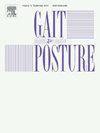Influence of wide-stance gait, foot progression modification and lateral trunk lean on knee contact forces in healthy adults: A musculoskeletal modelling-based study
IF 2.2
3区 医学
Q3 NEUROSCIENCES
引用次数: 0
Abstract
Objective
To evaluate the effects of wide-stance, toe-in, and lateral trunk lean gait modifications on knee joint contact forces (KCF) in healthy participants through motion capture and musculoskeletal modelling.
Methods
Twenty healthy participants completed walking trials under four gait conditions: natural walking, wide stance, toe-in, and lateral trunk lean. Walking biomechanics were recorded using an 8-camera motion capture system, synchronised with four ground reaction force plates. Kinematic and kinetic data were used to calculate right-limb KCF during early and late stance using an OpenSim-based musculoskeletal model. Within-subject differences in KCF across the four walking conditions were evaluated using a linear mixed model, accounting for speed as a covariate.
Results
Only medial-lateral forces were affected by condition during early stance, with wide-stance (p < 0.001, Cohen’s d=-0.91) and toe-in (p < 0.001, Cohen’s d=-1.28) gaits reducing medial KCF compared to natural gait, and toe-in exhibiting lower medial forces than lateral trunk lean (p < 0.001, Cohen’s d=-0.91). In late stance, both medial-lateral and vertical forces were condition dependent, with wide-stance (p < 0.001, Cohen’s d=-0.79) and toe-in (p < 0.001, Cohen’s d=-1.68) gaits continuing to reduce medial forces compared to natural gait. Toe-in gait further decreased medial forces relative to both wide-stance (p < 0.001, Cohen’s d=-0.90) and lateral trunk lean (p < 0.001, Cohen’s d=-1.39), while also lowering vertical forces in comparison to natural walking (p < 0.001, Cohen’s d=-0.90) and lateral trunk lean (p < 0.001, Cohen’s d=-0.77).
Conclusion
Gait retraining is an achievable intervention to immediately modify KCF in healthy adults, with toe-in gait demonstrating the most lateralisation of force amongst the walking conditions observed.
健康成人宽站立步态、足部进展改变和躯干侧倾对膝关节接触力的影响:一项基于肌肉骨骼模型的研究
目的通过运动捕捉和肌肉骨骼模型,评价宽站姿、趾内和侧躯干倾斜步态改变对健康受试者膝关节接触力(KCF)的影响。方法20名健康受试者在四种步态条件下完成步行试验:自然步行、宽站立、脚趾内伸和躯干侧倾。行走生物力学使用一个8摄像头运动捕捉系统进行记录,该系统与四个地面反作用力板同步。使用基于opensim的肌肉骨骼模型,利用运动学和动力学数据计算站立早期和晚期的右肢KCF。使用线性混合模型评估四种步行条件下KCF的受试者内部差异,将速度作为协变量。结果早期站立状态只影响内侧-外侧力,宽站姿(p <; 0.001,Cohen’s d=-0.91)和趾内(p <; 0.001,Cohen’s d=-1.28)步态比自然步态减少内侧KCF,趾内比外侧躯干倾斜内侧力更小(p <; 0.001,Cohen’s d=-0.91)。在站立后期,内侧侧向力和垂直力都是条件依赖的,与自然步态相比,宽站姿(p <; 0.001,Cohen’s d=-0.79)和脚朝内(p <; 0.001,Cohen’s d=-1.68)的步态继续减少内侧力。相对于宽站姿(p <; 0.001,Cohen’s d=-0.90)和躯干侧倾(p <; 0.001,Cohen’s d=-1.39),脚趾朝内的步态进一步降低了内侧力,同时与自然行走(p <; 0.001,Cohen’s d=-0.90)和躯干侧倾(p <; 0.001,Cohen’s d=-0.77)相比,也降低了垂直力。结论:步态再训练是一种可实现的干预措施,可立即改善健康成人的KCF,在所观察到的步行条件中,脚趾向内的步态显示出最侧向的力量。
本文章由计算机程序翻译,如有差异,请以英文原文为准。
求助全文
约1分钟内获得全文
求助全文
来源期刊

Gait & posture
医学-神经科学
CiteScore
4.70
自引率
12.50%
发文量
616
审稿时长
6 months
期刊介绍:
Gait & Posture is a vehicle for the publication of up-to-date basic and clinical research on all aspects of locomotion and balance.
The topics covered include: Techniques for the measurement of gait and posture, and the standardization of results presentation; Studies of normal and pathological gait; Treatment of gait and postural abnormalities; Biomechanical and theoretical approaches to gait and posture; Mathematical models of joint and muscle mechanics; Neurological and musculoskeletal function in gait and posture; The evolution of upright posture and bipedal locomotion; Adaptations of carrying loads, walking on uneven surfaces, climbing stairs etc; spinal biomechanics only if they are directly related to gait and/or posture and are of general interest to our readers; The effect of aging and development on gait and posture; Psychological and cultural aspects of gait; Patient education.
 求助内容:
求助内容: 应助结果提醒方式:
应助结果提醒方式:


